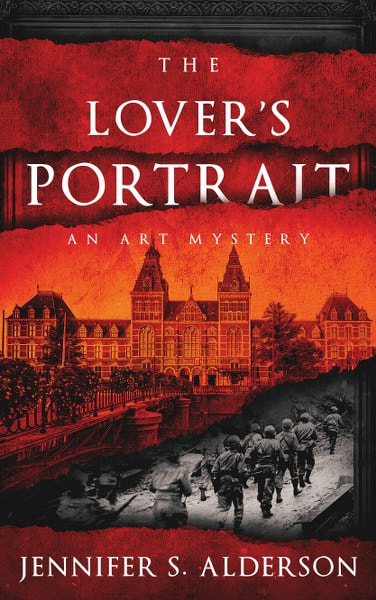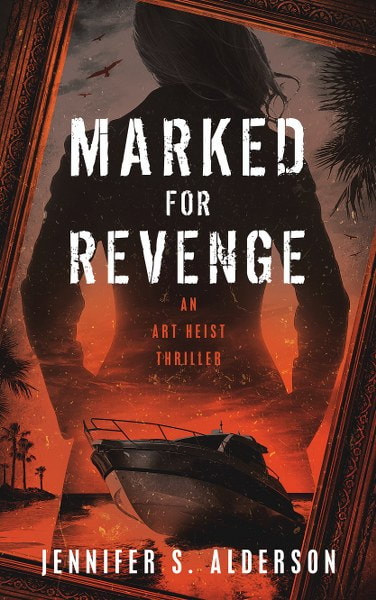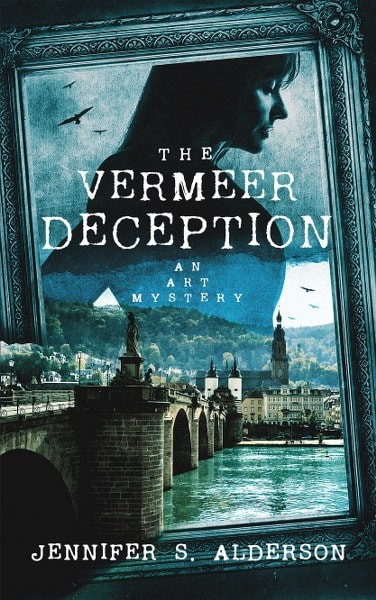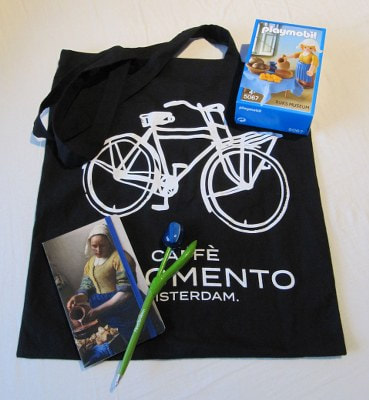The Lover's Portrait
Zelda Richardson Mystery Series Book 1
by Jennifer S. Alderson
Genre: Mystery, Thriller, Suspense
A portrait holds the key to recovering a cache of looted artwork, secreted away during World War II,
in this captivating historical art thriller set in the 1940s and present-day Amsterdam.
When a Dutch art dealer hides the stock from his gallery – rather than turn it over to his Nazi blackmailer
– he pays with his life, leaving a treasure trove of modern masterpieces buried somewhere in
Amsterdam, presumably lost forever. That is, until American art history student Zelda Richardson sticks
her nose in.
After studying for a year in the Netherlands, Zelda scores an internship at the prestigious Amsterdam
Museum, where she works on an exhibition of paintings and sculptures once stolen by the Nazis, lying
unclaimed in Dutch museum depots almost seventy years later.
When two women claim the same portrait of a young girl entitled Irises, Zelda is tasked with investigating
the painting’s history and soon finds evidence that one of the two women must be lying about her past.
Before she can figure out which one and why, Zelda learns about the Dutch art dealer’s concealed
collection. And that Irises is the key to finding it.
Her discoveries make her a target of someone willing to steal – and even kill – to find the missing
paintings. As the list of suspects grows, Zelda realizes she has to track down the lost collection and
unmask a killer if she wants to survive.
Awarded a B.R.A.G. Medallion by indieBRAG's readers in March 2019
Chosen as Chill with a Book’s January 2018 Book of the Month and winner of a Chill with a Book
Readers’ Award
One of TripFiction's 10 Favorite Books set in Amsterdam
Silver Cup winner in Rosie's Book Review Team 2017 Awards, Mystery category
Readers’ Favorite 5 star medal
One of The Displaced Nation magazine’s Top 36 Expat Fiction Picks of 2016
One of Women Writers, Women’s Books magazine's Recommended Reads for April 2017.
Set in present day and wartime Amsterdam, this captivating thriller is not just about stolen paintings, but
also the lives that were stolen. This art history mystery also describes the plight of homosexuals and
Jewish artists in Europe during World War II, as well as the complexities inherent to the restitution of
artwork stolen by the Nazis in the 1930s and 1940s.
The Lover's Portrait is Book One in the Zelda Richardson Mystery Series. The amateur sleuth
mysteries in this series can be read in any order.
Book Trailer
Rituals of the Dead
Zelda Richardson Mystery Series Book 2
A museum researcher must solve a decades-old murder before she becomes the killer’s next victim
in this riveting dual timeline thriller set in Papua and the Netherlands.
Agats, Dutch New Guinea (Papua), 1961: While collecting Asmat artifacts for a New York museum,
American anthropologist Nick Mayfield stumbles upon a smuggling ring organized by high-ranking
members of the Dutch colonial government and the Catholic Church. Before he can alert the authorities,
he vanishes in a mangrove swamp, never to be seen again.
Amsterdam, the Netherlands, 2018: While preparing for an exhibition of Asmat artifacts in a Dutch
ethnographic museum, researcher Zelda Richardson finds Nick Mayfield’s journal in a long-forgotten
crate. Before Zelda can finish reading the journal, her housemate is brutally murdered and ‘Give back
what is not yours’ is scrawled on their living room wall.
Someone wants ancient history to stay that way—and believes murder is the surest way to keep the past
buried.
Can she solve a sixty-year-old mystery before decades of deceit, greed, and retribution cost Zelda her
life?
Awarded a B.R.A.G. Medallion by indieBRAG's readers in December 2018
One of Amy's Bookshelf Reviews' Top 20 Books of 2018
Winner of a Chill with a Book Readers’ Award, June 2018
A Women Writers, Women’s Books magazine’s Recommended Reads for March 2018
New Apple’s 2018 Summer Book Awards, Official Selection Mystery/Thriller category
BookLife Prize for Fiction 2018, Mystery/Thriller category, rating 8.50
Art, religion and history collide in this edge-of-your-seat museum thriller, Book Two of the Zelda
Richardson Mystery Series. The novels in this series can be read in any order.
Marked For Revenge
Zelda Richardson Mystery Series Book 3
An exhilarating adventure set in the Netherlands, Croatia, Italy, Luxembourg, and Turkey about
stolen art, the mafia, and a father’s vengeance.
When researcher Zelda Richardson begins working at a local museum, she doesn’t expect to get
entangled with an art theft, knocked unconscious by a forger, threatened by the mob, or stalked by drug
dealers.
To make matters worse, a Croatian gangster is convinced Zelda knows where a cache of recently
pilfered paintings is. She must track down an international gang of art thieves and recover the stolen
artwork in order to save those she loves most.
The trouble is, Zelda doesn’t know where to look. Teaming up with art detective Vincent de Graaf may be
her only hope at salvation.
The trail of clues leads Zelda and Vincent on a pulse-pounding race across Europe to a dramatic
showdown in Turkey that may cost them their lives.
Awarded a Chill with a Book Readers' Award in June 2019
A Women Writers, Women's Books magazine Recommended Reads in June 2019
One of Amy's Bookshelf Reviews Top 20 Reads of 2019
Placed at #30 in ReadFreely's Top 50 Indie Reads of 2019
Chosen as Chill with a Book's June 2019 Cover of the Month
Marked for Revenge is the third book in the Zelda Richardson Mystery Series. The novels in this
series can be read in any order.
The Vermeer Deception
Zelda Richardson Mystery Series Book 4
An art historian finds – then loses – a portrait by Johannes Vermeer in this thrilling art mystery set in
Munich, Heidelberg, and Amsterdam.
When Zelda Richardson investigates a new lead about a missing portrait by Johannes Vermeer, no one
expects her to actually find the painting in a retired art dealer’s home in Munich, Germany. Not her
parents visiting from America; her boss, private detective Vincent de Graaf; or the rightful owner of the
Nazi-looted artwork.
However, Zelda’s jubilation turns to horror when she arrives to pick up the portrait and finds the art
dealer dead and several frames smoldering in his fireplace.
Was the Vermeer a fake and its ‘discovery’ a cruel joke played on a Nazi victim? The Munich police,
Zelda’s family, and Vincent certainly think so.
Yet the art dealer’s best friend believes he was murdered and the real Vermeer stolen by an
underground network of art looters, one established during World War II and still active today. The
problem is, no one believes him – except Zelda.
Zelda soon finds herself in a dangerous game of cat-and-mouse with immoral art collectors, corrupt
dealers, and an all-to-real killer who wants her to stop searching.
Can Zelda uncover the truth about the Vermeer before she is painted out of the picture permanently?
The Vermeer Deception is Book 4 in the Zelda Richardson Mystery Series. The novels in this series
can be read in any order.
**On Sale for only $2.99!**
Hi! I am an American expat currently living in Amsterdam. After traveling extensively around Asia,
Oceania, and Central America, I moved to Darwin, Australia, before finally settling in the Netherlands.
When not writing, you can find me in a museum, biking around Amsterdam, or enjoying a coffee along
the canal while planning my next research trip.
My love of travel, art, and culture inspires my award-winning Zelda Richardson Mystery series, Travel
Can Be Murder Cozy Mysteries, and standalone stories.
The Lover’s Portrait (Book One) is a suspenseful whodunit about Nazi-looted artwork that transports
readers to WWII and present-day Amsterdam. Art, religion, and anthropology collide in Rituals of the
Dead (Book Two), a thrilling artifact mystery set in Papua New Guinea and the Netherlands. My pulse-
pounding adventure set in the Netherlands, Croatia, Italy, and Turkey— Marked for Revenge (Book
Three)—is a story about stolen art, the mafia, and a father’s vengeance.
The Travel Can Be Murder Cozy Mysteries are a funny new series featuring tour guide and amateur
sleuth, Lana Hansen. Join Lana as she leads tourists and readers to fascinating cities around the globe
on intriguing adventures that, unfortunately for Lana, often turn deadly. Book One— Death on the
Danube —takes Lana to Budapest for a New Year’s trip. Can Lana figure out who murdered her fellow
tour guide before she too ends up floating in the Danube? Death by Baguette: A Valentine's Day Murder
in Paris (Books Two) will be released in February 2020, and Book 3 in May 2020.
I am also the author of Down and Out in Kathmandu , Holiday Gone Wrong , and Notes of a Naive
Traveler .
Connect with me on Goodreads, Facebook, Twitter, Instagram, or my website.
I have also started a group for readers and writers of travel fiction and non-fiction - Travel By Book. We
are a promotion and discussion group active on Facebook with a growing presence here on
Goodreads.
Thanks for stopping by!
GUEST POST
The
Colonial Origins of Ethnographic Museums
Article
about Rituals
of the Dead
by Jennifer S. Alderson
Since
I finished writing Rituals
of the Dead,
I have noticed an influx in news reports about the restitution of
ethnic artifacts – a topic central to my latest mystery. So we are
clear, I am not referring to antiquities such as the Parthenon
Marbles (or Elgin Marbles, depending on your nationality). I’m
talking about shrunken heads, painted shields, feathered headdresses,
carved ancestor sculptures, ritual masks, and the like. The same
objects currently filling western museums dedicated to anthropology
and ethnography.
At
first, I thought it was a side effect of my research; I was simply
noticing these kinds of articles more often. After all, I’d just
spent months pouring over accounts of anthropologists, missionaries,
and colonial administers who brought Asmat artwork – specifically
bis poles – back home from Papua New Guinea and donated or sold
them to Dutch ethnographic museums.
“African
Heritage Cannot be the Prisoner of French Museums”
However,
I now believe this recent increase in news coverage has
everything to do with a promise French President Emmanuel Macron made
on November 28, 2017 while in Burkina
Faso. He
announced the restitution of African artifacts was a priority,
stating, “I
cannot accept that a large part of the cultural patrimony of several
African countries is in France. There are historical explanations for
this, but there is no valid, durable, or unconditional justification
for it. Africa’s patrimony must be celebrated in Paris but also in
Dakar, Lagos, and Cotonou.”
He
later reiterated his statement by tweeting,
“African heritage cannot be the prisoner of French museums”. Many
believe this pledge was in response to Benin’s request for the
return of thousands of “colonial treasures” taken at the turn of
the century. A French court of law denied Benin’s claim.
Macron’s
remarks shines a spotlight on the origins of western ethnographic
museum collections and have re-invigorated calls for restitution.
Almost all of these cases concern objects collected for western
museums from colonized nations in Africa, South America and Oceania
between 1900 and 1970.
Exotic
Representations of “The Other”
These
artifacts were acquired as representations of the indigenous group’s
“otherness”. Anything and everything was shipped back home –
ancestor statues (such as bis poles), shrunken heads, decorated
skulls, kitchen utensils, weapons, shields, musical instruments,
sleeping mats, bowls, and even door frames. The weirder, the better.
These
objects were desired by both museums and private collectors. Public
displays emphasized the primitive nature of the indigenous groups’
artistic expression or spiritual beliefs. These exhibitions were also
a way of asserting western superiority over these regions and
peoples, used to justify their colonization and the (often forced)
conversion to Christianity of those living within these colonies. In
pretty much every case of colonization, the church was there from the
beginning, busy converting locals in the belief they were saving
their souls, while helping them adjust to western culture, customs,
and technological advancements. Papua New Guinea was no exception.
My
summary probably seems harsh to you because society has progressed
and our attitudes have thankfully changed.
Decolonization
and Western Ethnographic Museums
Decolonization
in the 1960s and 1970s resulted in a new call for equal rights by
indigenous peoples – within their own lands and abroad. It also
meant that some of these ‘exotic’ peoples were now immigrating to
the colonial motherland. In the Netherlands, their presence dictated
a change in the ways these people were represented in the country’s
ethnographic museums.
Many
of these museums’ showpieces were removed from public displays and
hidden away in their depots. New exhibitions were created which
focused on geographical and statistical information, as a way of
introducing these post-colonial nations to western viewers. They were
often neutral displays, heavily dependent on photographs to
illustrate aspects of daily life, such as the ways homes were
constructed, fields were sown and the types of clothes locals wore.
Only
in the last decade or so have these older artifacts been brought back
out of storage. However, they are no longer displayed as examples of
a people’s “exotic otherness”, but as sublime examples of their
cultural and artistic traditions.
Reasserting
Cultural Identity
One
of the side effects of the conversion to Christianity was the
disappearance of these indigenous groups’ artistic traditions.
Sometimes they were voluntarily given up by peoples no longer
interested in keeping the “old ways” alive. In other cases, such
as Papua New Guinea, their traditions and rituals were banned by
Christian missionaries and colonial governments, as part of the
pacification process.
Nowadays,
the objects collected in the 1900s and displayed in western museums
are often the finest examples of an artistic tradition that has died
out in its country of origin. Pride of culture has led many
recently-formed nations and indigenous groups to try and revive these
traditions, as a way of reasserting their cultural identity. Their
desire to see these historically-significant artifacts returned has
also grown stronger.
An
increasing number of countries in Africa, South America and Oceania
are submitting claims on these precious examples of their ancestors’
craftsmanship and artistry. So far, the response has been mixed. More
often than not, their claims have been denied.
In
light of Macron’s
promise,
how Western museums respond to these new restitution claims will be
telling. How deeply-seated are feelings of colonial pride in the
present generation? And are western museums willing to give up the
best pieces in their ethnographic collections – and risk becoming
obsolete – to help these former colonies establish their own
cultural institutions?
Author’s
note:
This is a brief introduction to an extraordinarily complex topic. It
is based on research I conducted while working as a collection
researcher for the Tropenmuseum, writing my master’s thesis, and my
novel Rituals
of the Dead.
References
to French President Macron’s promise to return African art:
La
Monde Afrique:
http://www.lemonde.fr/afrique/article/2017/12/01/la-restitution-des-uvres-issues-des-pillages-coloniaux-n-est-plus-un-tabou_5223058_3212.html
"Art-related, Dutch goodies" prize package, includes:
- Playmobil toy of Vermeer's The Milkmaid (from the Rijksmuseum)
- A notebook featuring Vermeer's The Milkmaid on the cover
- A tulip pen
- A fabric bag from a local Amsterdam cafe












No comments:
Post a Comment